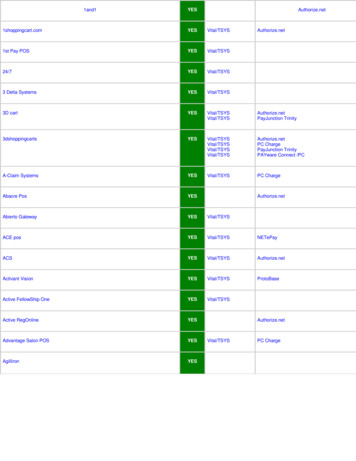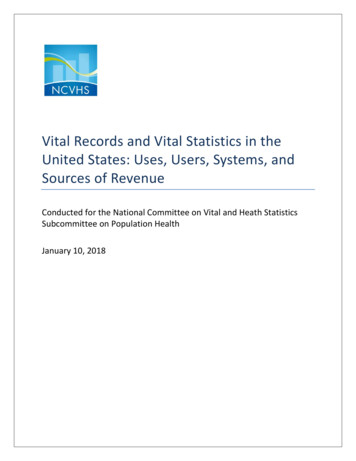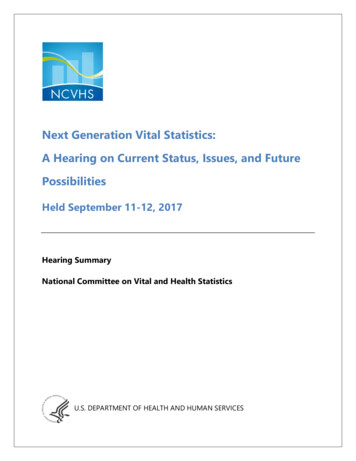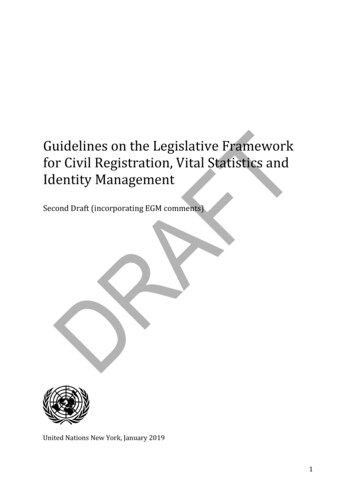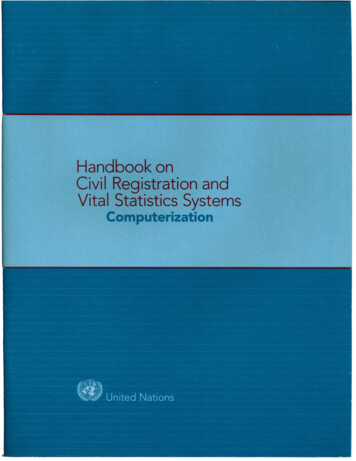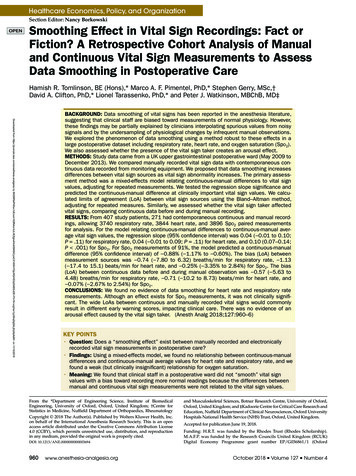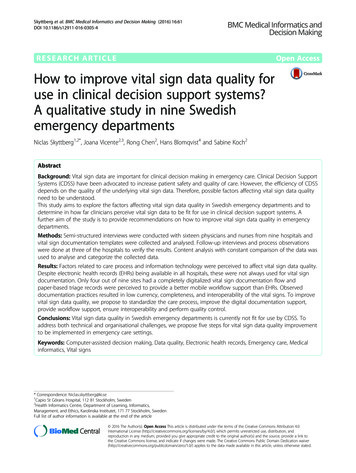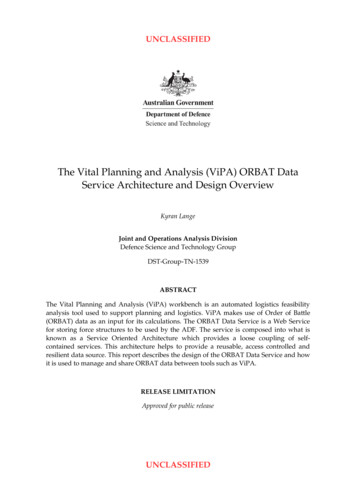
Transcription
UNCLASSIFIEDThe Vital Planning and Analysis (ViPA) ORBAT DataService Architecture and Design OverviewKyran LangeJoint and Operations Analysis DivisionDefence Science and Technology GroupDST Group TN 1539ABSTRACTThe Vital Planning and Analysis (ViPA) workbench is an automated logistics feasibilityanalysis tool used to support planning and logistics. ViPA makes use of Order of Battle(ORBAT) data as an input for its calculations. The ORBAT Data Service is a Web Servicefor storing force structures to be used by the ADF. The service is composed into what isknown as a Service Oriented Architecture which provides a loose coupling of self contained services. This architecture helps to provide a reusable, access controlled andresilient data source. This report describes the design of the ORBAT Data Service and howit is used to manage and share ORBAT data between tools such as ViPA.RELEASE LIMITATIONApproved for public releaseUNCLASSIFIED
UNCLASSIFIEDPublished byJoint and Operations Analysis DivisionDefence Science and Technology GroupWest AvenueEdinburgh, South Australia 5111 AustraliaTelephone: 1300 333 362Fax: 61 8 7389 6567 Commonwealth of Australia 2016AR 016 657Updated July 2016Approved for Public ReleaseUNCLASSIFIEDDST Group TN 1539
UNCLASSIFIEDThe Vital Planning and Analysis (ViPA) ORBAT DataService Architecture and Design OverviewExecutive SummaryThe Vital Planning and Analysis (ViPA) workbench is an automated logistics feasibilityanalysis tool used to support planning and logistics. ViPA makes use of Order of Battle(ORBAT) data as an input for its calculations. ORBATs describe the identification,strength, command structure, and disposition of the personnel, units, and equipment of amilitary force. They are complicated structures which are often captured in spreadsheetsand maintained by various personnel over long periods of time in different levels of detailfor a range of purposes. However, there was previously no authoritative, consolidated,shared source of ORBAT data in the Australian Defence Force (ADF).The ORBAT Data Service was developed by the DST Group in 2008 to addressrequirements identified by the Logistics Planning Dedicated User Group (DUG) formodelling and sharing ORBAT data. The DUG was run and managed by StrategicLogistics Branch (SLB) for input, review and comment on the creation of userrequirements for logistics operations planning tools. The ORBAT Data Service has sincebeen deployed onto laptops that were taken into theatres overseas, installed on theMission Secret Network (MSN) for Army exercises, and has been transitioned to theDefence Restricted Network (DRN) and the Defence Secret Network (DSN) by Defenceproject JP2030.The ORBAT Data Service is a Web Service for storing force structures to be used by theADF. Web Services are software used to share business logic and data across a networkthrough application programming interfaces (APIs) using open standards to simplifysharing and reuse. The service is composed into what is known as a Service OrientedArchitecture which provides a loose coupling of self contained services. This architecturehelps to achieve the design intent of the ORBAT Data Service to be a reusable, accesscontrolled and resilient data source.Part of the work in creating the service involved developing a data model for storing forcestructures and including the dynamic relationships between them. This included asolution for capturing the temporal dimension of force structures to represent changes incapability and force composition (e.g. unit rotations) over time. The data model caters fordifferent types of ORBATs, namely generic capability bricks, force in being, hypotheticalfuture forces, etc. Robust APIs were also designed to expose a powerful service thatenables users to create, search, read, update and delete data models of ORBATS.A comprehensive data management process was also designed and built into the service tosupport a rigorously managed collection of accurate, fit for purpose data with associatedmetadata.ORBAT data services enable the Australian Defence Organisation to access authoritativeORBAT data using various applications in a number of domains including operationsUNCLASSIFIED
UNCLASSIFIEDplanning, logistics analysis and planning, joint movement and preparedness. It allows fordifferent instances of an ORBAT data service to be set up to manage different types of datafor actual operations, specific exercises, simulations, strategic analysis, training, etc. and itis also deployable for standalone use on laptops or on fixed and adhoc networks.This report describes the design of the ORBAT Data Service and how it is used to manageand share ORBAT data between tools such as ViPA.AcknowledgementsI would like to thank and acknowledge Mr Shane Reschke who co developed the ORBATData Service and wrote some documentation which was used to create this report.I would also like to thank Dr Mark Nelson who read through drafts of this report andprovided many helpful suggestions. His help was invaluable.I would also like to thank both Mr Hing Wah Kwok and Mr Kuba Kabacinski (ConsunetPty Ltd) for aiding with some of the concepts outlined in this paper. Kuba also contributeddocumentation which was used in the creation of this report.UNCLASSIFIED
UNCLASSIFIEDDST Group TN 1539ContentsGlossary.1. Introduction.11.1 Related Work.21.2 Purpose.51.3 Intended Audience.51.4 Document Structure.52. ViPA.62.1 Background.62.2 Support to Planning.72.3 Architecture.83. Main Requirements.104. Data Model.134.1 Relationships.204.1.1 Static Link vs Dynamic Link.214.1.2 Relationships Between ORBATs.214.1.3 Relationships Between Units.234.1.4 Relationships in a DPR.234.2 Type Restrictions.244.3 Capability Brick Construction.244.4 Mandatory Fields.274.5 Symbology.275. Temporal Modelling and Entity Versioning.285.1 Temporal Design.295.2 Temporal Linking.306. Fetching Strategies.316.1 Temporal Fetching Strategies.316.2 Timeline – Version Continuity.386.3 Fetching Dependencies.396.4 Lazy Loading.396.4.1 ORBAT of Units.416.4.2 ORBAT of ORBATs.417. Service Interface.427.1 General Interface.437.1.1 getORBAT/getUnit.437.1.2 searchORBAT/searchUnit/search.457.1.2.1 Entity Name Search.45UNCLASSIFIED
DST Group TN 1539UNCLASSIFIED7.1.2.2 Type/Structure Type Filter.467.1.2.3 General Field Search.467.1.2.4 Specific Field Search.477.1.2.5 Current/Latest Search.487.1.2.6 Association Search.497.1.2.7 Orphan Search.497.1.2.8 Temporal Search.497.1.3 summariseUnits/summariseORBATs.507.1.4 summariseUnitsExpanded.527.1.5 getUnitSummary.557.1.6 get2525Symbol.557.1.7 listCapabilities/listPrimaryCapabilities.557.2 Administration Interface.567.2.1 putORBAT/putUnit.567.2.2 depORBAT/depUnit.567.2.3 getDraftORBAT/getDraftUnit.577.2.4 updateState.577.2.5 searchORBAT/searchUnits/search.577.2.6 getAuthorisedRoles.577.2.7 getUserJurisdiction.577.2.8 getRepositoryID.577.2.9 listCapabilities/listPrimaryCapabilities.577.3 REST Interface.587.4 ORBAT Administration Client.588. Design.618.1 Design Patterns.618.2 Technology.619. Data Management Framework.639.1 Data Management Stages.639.1.1 Manage.639.1.2 Capture.649.1.3 Verify.649.1.4 Publish.669.1.5 Consume.669.1.6 Validate.669.1.7 Cleanse.669.1.8 Data Migration.669.1.9 Deprecate.669.2 Entity States.679.3 Linking to Draft Entities.689.4 Use Cases.689.4.1 Creating an ORBAT from Scratch.689.4.2 Editing an ORBAT Without Editing its Units.699.4.3 Editing an ORBAT and its Units.69UNCLASSIFIED
UNCLASSIFIEDDST Group TN 15399.4.4 Verifying and Approving an ORBAT.699.5 Jurisdiction Based Edit Restrictions.709.6 Data Synchronisation and Multi Repository Deployment.7010. Model Management.7410.1 Security.7410.2 Performance.7510.3 Concurrency.7610.4 Data Validation.7710.5 Data Auditing.7910.6 Data Persistence.8010.7 Data Mapping.8111. Future Work.8211.1 Phase Out the Data Management Framework.8211.2 Data Model Improvements.8211.3 Container ORBATs.8311.4 Improved Reporting.8311.5 Capability Hierarchy.8411.6 Graphical ORBAT Administration Client.8412. References.8713. Appendix A: ORBAT Data Model Schema.9114. Appendix B: ORBAT Data Model Validation Rules.105UNCLASSIFIED
DST Group TN 1539UNCLASSIFIEDThis page intentionally blankUNCLASSIFIED
UNCLASSIFIEDGlossaryADFAustralian Defence ForceAMAide MemoireAMDSAide Memoire Data ServiceAPIApplication Programming InterfaceASJETSAustralian Joint Essential TasksCOACourse of ActionCONOPSConcept of OperationsDESDefence Entitlement SystemDMODefence Materiel OrganisationDPRDefence Preparedness RequirementDRNDefence Restricted NetworkDSNDefence Secret NetworkDST GroupDefence Science and Technology GroupDSTODefence Science and Technology OrganisationDUGLogistics Planning Dedicated User GroupEISEnterprise Information SystemsFTEFull Time EntitlementHTMLHyper Text Markup LanguageHTTPHyper Text Transfer ProtocolHQHeadquartersIBMInternational Business Machines CorporationIDAIntegrated Defence ArchitectureJava EEJava Platform, Enterprise EditionJAX WSJava API for XML Web ServicesUNCLASSIFIEDDST Group TN 1539
UNCLASSIFIEDDST Group TN 1539JAXBJava Architecture for XML BindingJDBCJava Database ConnectivityJIPBJoint Intelligence Preparation of the BattlespaceJLOJoint Logistics OrientationJMAPJoint Military Appreciation ProcessJPAJava Persistence APIJTDSJoint Training Data ServicesLELoan EntitlementMLOCMinimum Level of CapabilityMVCModel View ControllerNATONorth Atlantic Treaty OrganizationODMOrder of Battle Data ModelOLOCOperational Level of CapabilityOPOOperational Preparedness ObjectiveORBATOrder of BattleORBATDSOrder of Battle Data ServiceORBOORBAT of ORBATsORMObject/Relational MappingOWGORBAT Services Working GroupPOJOPlain Old Java ObjectsRCP(Eclipse) Rich Client PlatformRDBMSRelational Database Management SystemRESTREpresentational State TransferRTSRaise, Train, SustainSIDCSymbol ID CodeUNCLASSIFIED
UNCLASSIFIEDDST Group TN 1539SLBStrategic Logistics BranchSMESubject Matter ExpertSOAService Oriented ArchitectureSOAPSimple Object Access ProtocolSPASecurity Protected AssetsTOPFASTool for Operations Planning Functional Area ServiceUEUnit EntitlementUIUser InterfaceUMLUnified Modeling LanguageViPAVital Planning and AnalysisWUCWeapon User CategoryXMLExtensible Markup LanguageXPAeXtreme Programming ActivityXSLExtensible Stylesheet LanguageXSLTXSL TransformationUNCLASSIFIED
DST Group TN 1539UNCLASSIFIEDThis page intentionally blankUNCLASSIFIED
UNCLASSIFIEDDST Group TN 15391. IntroductionThe Vital Planning and Analysis (ViPA) workbench is an automated logistics feasibilityanalysis tool used to support planning and logistics. ViPA makes use of Order of Battle(ORBAT) data as an input for its calculations. ORBATs describe "The identification,strength, command structure, and disposition of the personnel, units, and equipment ofany military force."[22] They are complicated structures which are usually captured inspreadsheets and maintained by various personnel over long periods of time in differentlevels of detail for a range of purposes. However, there was previously no authoritative,consolidated, shared source of ORBAT data in the Australian Defence Force (ADF).The ORBAT Data Service (ORBATDS) was developed by the Defence Science andTechnology Group (DST Group) in 2008 to address requirements identified by theLogistics Planning Dedicated User Group (DUG) for modelling and sharing ORBAT data.The DUG was run and managed by Strategic Logistics Branch (SLB) for input, review andcomment on the creation of user requirements for logistics operations planning tools.The ORBATDS is a Web Service which acts as a storage facility for different types ofORBATs including generic force structures (i.e. capability bricks), actual force structures(i.e. force in being and unit entitlements) and capability lists for Defence PreparednessRequirements (DPRs).Web Services are software used to share business logic and data across a network throughapplication programming interfaces (APIs) using open standards to simplify sharing andreuse. The service is composed into what is known as a Service Oriented Architecture(SOA) which provides a loose coupling of self contained services. This architecture helpsto achieve the design intent of the ORBAT Data Service to be a reusable, access controlledand resilient data source. The purpose of the service is to store these various ORBATs andcontrol access across different applications. Thus applications can consume these ORBATsand modify them locally within the application to satisfy their business requirements oralternatively applications can consume, modify and produce ORBATs for storage backinto the service.A particularly challenging aspect not handled before is how force structures change overtime. Force structures in defence change for a number of reasons including through unitrotations while on deployment, with the introduction of new capabilities (e.g. newequipment) and with the Defence White Paper which provides guidance about Australia'slong term defence capability. By adding a temporal dimension to the data stored in theORBATDS it is possible to model the evolution of the force over time and then to useplanning and simulation tools to analyse the impacts of that change on ADF capability invarious scenarios.Historically the ADF has used a variety of methods for maintaining ORBATs. Not all ofthese are formalised and included the use of notebooks, spreadsheets and presentationslides, with email and formatted military messaging used to distribute ORBATinformation. There are some problems with this haphazard method of maintainingUNCLASSIFIED1
DST Group TN 1539UNCLASSIFIEDORBAT data. Firstly, by not having a centralised source of truth it is difficult to knowwhether the information you currently have is up to date. Because copies are gettingemailed and forwarded, possibly with modifications, there is no easy method to knowhow correct the version you are looking at is. This leads to wasted effort in determiningthe correctness of the information and makes collaboration very difficult.The ORBATDS addresses many of these problems. As it is a web service it is not tied toany particular user ORBAT editing application, thus allowing potentially multiple userinterfaces to be created for specific purposes. The SOA based design more easilyaccommodates the uptake of new information technologies. The ORBATDS has beendesigned to allow for multiple services to co exist making it scalable for differentsituations. By following open standards it is easily interoperable with other applicationswhich assists in information sharing and openness. Being a Web Service also assists withcollaboration. Multiple people can interact with the service simultaneously using it as aplatform for collaboration. In addition, it meets the need for a centralised authoritativedata source of force information. When users access data from the service they can beguaranteed that it is the most accurate and up to date representation of the force that isavailable.ORBAT data services enable the Australian Defence Organisation to access authoritativeORBAT data using various applications in a number of domains including operationsplanning, logistics analysis and planning, joint movement and preparedness. It allows fordifferent instances of an ORBAT data service to be set up to manage different types of datafor actual operations, specific exercises, simulations, strategic analysis, training, etc. and itis also deployable for standalone use on laptops or fixed and adhoc networks.The ORBATDS has been transitioned to the Defence Restricted Network (DRN) and theDefence Secret Network (DSN) by Defence project JP2030. The ORBATDS has also beendeployed onto laptops that were taken into theatres overseas, installed on the MissionSecret Network (MSN) for Army exercises, and is attracting interest from other parties.1.1 Related WorkThe Australian Army have a system called the Defence Entitlements System (DES) whichis used to manage an instance of ORBAT data called Unit Entitlements (UEs). This has acommand line interface and has maintenance issues due to the small number of peoplewho are familiar with this legacy system. It acts as a centralised repository for the UEs, buthandles information sharing poorly as the UEs are exported into a spreadsheet which isthen distributed. This causes the same problems as mentioned above. The data is alsodifficult to then use in other applications due to the lack of open standards.There are a number of foreign tools used to assist with the management of, and facilitatethe use of, ORBAT data. The Tool for Operations Planning Functional Area Services(TOPFAS) provides data and planning support tools for North Atlantic TreatyOrganization (NATO) operational planning. It is developed by the NATO Consultation,2UNCLASSIFIED
UNCLASSIFIEDDST Group TN 1539Command and Control (C3) Agency, together with partners from industry since before2001 [29]. TOPFAS has a component called the ORBAT Management Tool (OMT) which isused to populate the TOPFAS database with the ORBAT to support the operationalplanning process. The OMT, similarly to the ORBATDS discussed in this report, cansupport the representation of real units as well as generic units and allows for the breakingdown of units into command structures. TOPFAS outputs are Microsoft PowerPoint andMicrosoft Word documents. [26, 27]Another related work is the Joint Training Data Services (JTDS) which is sponsored by theUnited States of America Department of Defense Joint Staff J7. It is a web based set ofservices that provide modelling and simulation ready data and scenario developmenttools to support theatre level constructive training [23]. JTDS comprises three services [24],one of which is the Order of Battle Service (OBS). The OBS provides distributed editingand validation with user assignable permissions, a web based data repository and theability to 'drag and drop' entities to form a scenario.Prior to 2005 an ORBAT Services Working Group (OWG) was established involvingDefence Materiel Organisation (DMO), DST Group and Defence Industry staff. The OWGrole was to ensure that ORBAT tools and ORBAT data used in multiple AustralianDefence systems interoperate to a level acceptable to the Command Support SystemsBranch of the DMO. The OWG met formally on four occasions and the results weredocumented by Coomber et. al. [11]. During the meetings, concepts, use cases andspecifications were evolved through the development of a number of prototypes by bothDST Group and industry. This experience was distilled as a detailed design for ORBATservices including definitions of it's data model, interface and technologies. The ORBATDSshares some of the design developed by the OWG, most importantly by being a WebService. In addition, the ORBATDS data model shares many similarities and thetechnologies used such as XML, WSDL and SOAP make it compatible with their design.XSLT could be used to share data between the data models making the ORBATDSinteroperable with the specification developed by the OWG.One of the ways the ORBATDS differs from the OWG specification is it's adoption of theMIL STD 2525B w/CHANGE 2 symbology standard [31]. Military symbology is usedwidely within the military to denote ORBATs and their capability so it is important for thisinformation to be captured and used by the ORBATDS. Unfortunately various aspects ofsymbology have been adopted inconsistently across the ADF making finding a suitablestandard to implement difficult. Based on army doctrine publications, LWP G 0 1 5Military Symbology is the doctrinal publication for the military symbols, whichunfortunately at the time was not yet published with the previous publication being from1997 and marked as obsolescent. Minutes of the 2 09 Joint Operations DoctrineMa
The Vital Planning and Analysis (ViPA) ORBAT Data Service Architecture and Design Overview Kyran Lange Joint and Operations Analysis Division Defence Science and Technology Group DST Group TN 1539 ABSTRACT The Vital Planning and Analysis (ViPA) workbench is an automated logistics feasibility analysis tool used to support planning and .


